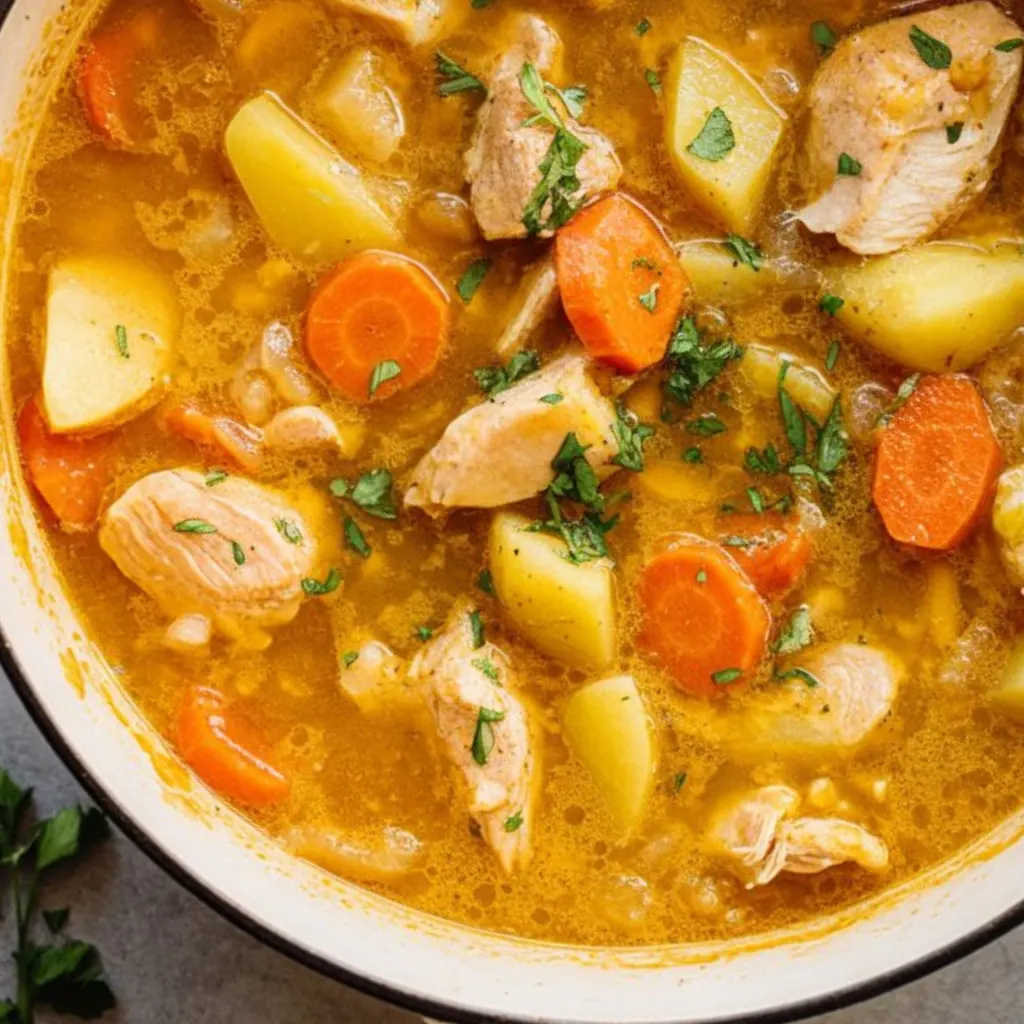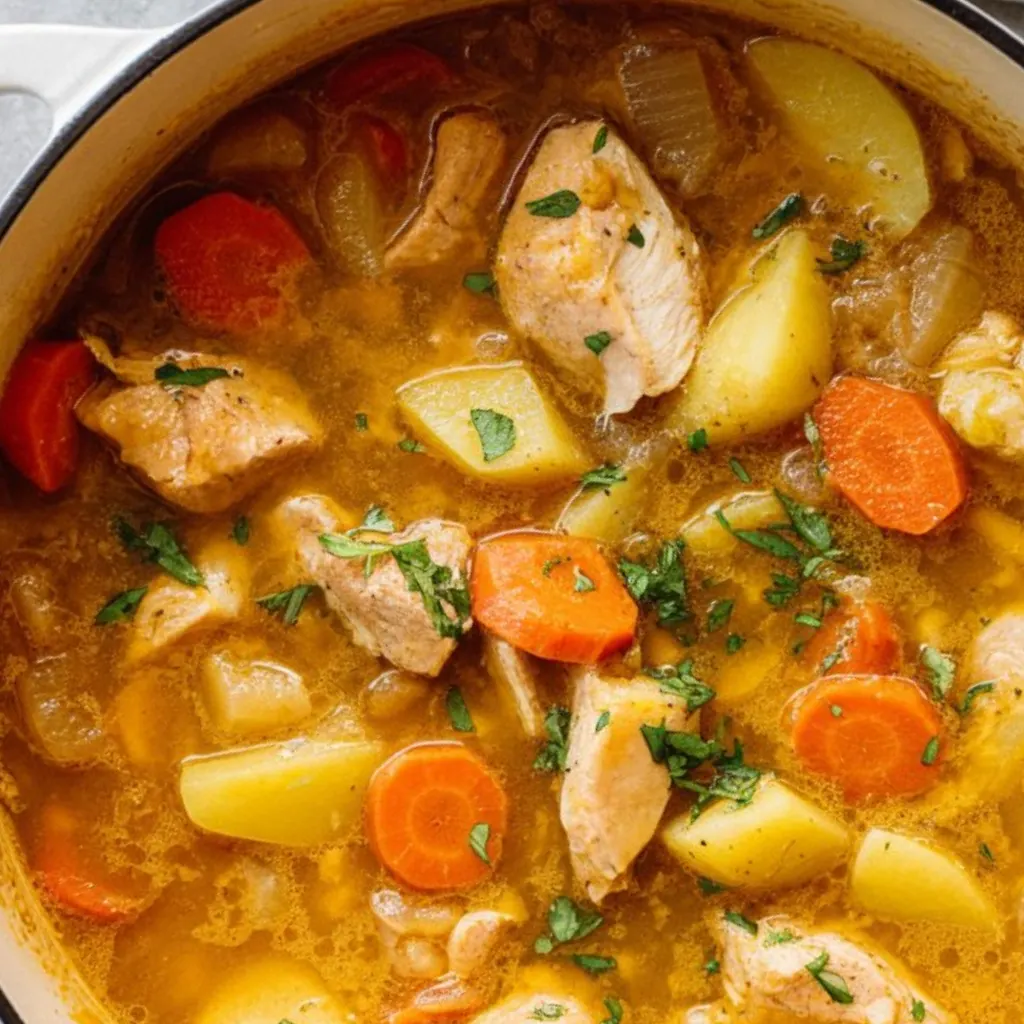I’ll never forget the first time I truly fell in love with chicken stew. It was a gray, drizzly Saturday when I was a young cook trying to fill a cold apartment with warmth and comfort. I had a few chicken thighs in the fridge, some leftover vegetables, and a vague hope that the magic would happen. I chopped, stirred, and simmered with a mix of trepidation and curiosity.
By the time I ladled the first bowl, the savory aroma had filled the kitchen in a way that made me feel like I had finally learned something essential about home cooking: the simplest ingredients, given attention and care, could turn into something extraordinary.
That stew wasn’t perfect—some carrots were overcooked, the broth needed more seasoning—but it was love in a pot. Over the years, I’ve refined that recipe, learned from my mistakes, and found that chicken stew has this rare quality: it comforts, nourishes, and brings people together without ever asking for recognition.

Why You’ll Love This Recipe
- Hearty and filling, perfect for cozy evenings
- Made with simple, affordable ingredients
- Easy to customize with whatever vegetables you have on hand
- Great for meal prep or leftovers
- A timeless, crowd-pleasing classic
Ingredients You’ll Need
For the Stew:
- 2 tablespoons olive oil or butter: I usually combine the two—olive oil prevents burning, butter adds richness.
- 1 medium onion, chopped: Yellow or sweet onions both work; they give a subtle sweetness to balance the savory broth.
- 3 carrots, peeled and sliced: I like thick slices so they don’t disintegrate while simmering.
- 2 celery stalks, chopped: The classic aromatics; they add a quiet, earthy flavor.
- 3–4 garlic cloves, minced: Fresh garlic makes all the difference. I sometimes roast it for a milder, sweeter touch.
- 1 teaspoon dried thyme or 2 sprigs fresh thyme: Thyme has that comforting, homey flavor that defines a classic stew.
- 2 bay leaves: Always remove before serving. They do their job quietly, adding depth.
- 4 cups chicken broth: Homemade if possible, but a good-quality store-bought broth works just fine.
- 1–1.5 pounds bone-in, skinless chicken thighs: I prefer thighs for their tenderness, but breasts are fine if that’s what you have.
- 2–3 medium potatoes, peeled and cubed: Yukon Golds hold their shape well, but russets or reds work too.
- 1 cup frozen peas or corn (optional): Adds sweetness and color toward the end.
- Salt and pepper, to taste: Always adjust at the end. Broth brands vary.
Optional Thickener:
- 2 tablespoons flour or cornstarch mixed with 2 tablespoons cold water: If you prefer a thicker stew, I’ll explain when to add it.
How to Make It (Step-by-Step Instructions)
Step 1: Brown the Chicken
Heat the oil and butter in a large heavy-bottomed pot over medium heat. Pat your chicken dry and season lightly with salt and pepper. Add the chicken pieces to the pot and sear until golden brown on all sides, about 3–4 minutes per side. Don’t worry if it’s not fully cooked through—that will happen in the stew. Browning is about flavor, not doneness. I used to skip this step when I was in a rush, and the stew always tasted flatter.
Step 2: Sauté the Vegetables
Remove the chicken and set it aside. In the same pot, add the onion, carrots, and celery. Let them cook gently for 5–7 minutes until softened and fragrant. Stir occasionally, scraping up any browned bits from the chicken—they carry a lot of flavor. Add the garlic and thyme and cook for another minute. This step is about layering flavors, and I’ve learned the hard way that rushing it leads to a one-dimensional broth.
Step 3: Build the Broth
Return the chicken to the pot. Pour in the chicken broth, add bay leaves, and bring to a gentle boil. Reduce the heat to a simmer and cover. Let it cook for 25–30 minutes, until the chicken is tender and the vegetables are cooked through.
Step 4: Add Potatoes and Optional Thickener
Add the cubed potatoes and simmer for another 15–20 minutes. If you like a thicker stew, stir in the flour or cornstarch slurry now. Keep the heat low and cook for an additional 5 minutes until the stew has thickened. Taste and adjust salt and pepper.
Step 5: Add Finishing Touches
Remove the chicken pieces, shred them with two forks, and return them to the pot. Stir in frozen peas or corn if using. Let the stew sit on very low heat for 5 more minutes to heat the peas through. Remove bay leaves before serving. Ladle into bowls and enjoy—the warmth, aroma, and comfort are immediate.

Expert Tips for the Best Results
The magic of chicken stew lies in patience and balance. Don’t rush the browning or the simmering—the flavors develop slowly and reward you with depth and richness. Keep your heat low during the simmer, or your vegetables will break down too much. Taste and adjust seasoning at the end; it’s easy to overdo salt early on. If you like a slightly thicker consistency, always mix your flour or cornstarch with cold water before adding it to prevent lumps. And finally, remember that stew always tastes better the next day—the flavors marry beautifully after resting.
Variations & Substitutions
Over the years, I’ve experimented with countless variations. Once, I was out of potatoes and tossed in cubed sweet potatoes instead—they added a gentle sweetness that was unexpectedly delightful. Another time, I added parsnips and turnips, giving it an earthy, wintery feel. If you’re short on chicken thighs, boneless breasts or even leftover rotisserie chicken work well. For a slightly different texture, you can swap the standard vegetables for butternut squash or mushrooms. The key is flexibility—the stew welcomes improvisation, and I’ve found the “mistakes” often turn into my favorite versions.
Serving Suggestions
Chicken stew is incredibly versatile. I love it served with warm, crusty bread to soak up every last drop of broth, or alongside a simple green salad for a lighter meal. It’s perfect for casual family dinners, cold evenings when you need comfort, or even for entertaining when paired with roasted vegetables and a glass of white wine. The beauty of stew is that it’s forgiving, comforting, and always ready to make anyone at the table feel at home.
Storage & Reheating Instructions
Leftovers store beautifully in the fridge for up to three days. I always reheat gently on the stovetop over low heat, stirring occasionally and adding a splash of broth or water if the stew thickened too much. The flavors deepen overnight, so if you can resist, consider making it a day ahead—it often tastes even better. Freezing works well too; portion it into airtight containers, and thaw overnight in the fridge before gently reheating. Note that potatoes may soften slightly in the freezer, but it rarely detracts from the comforting texture.
Recipe FAQs (Answered by Clara)
Can I make this ahead of time?
Absolutely. I often prepare it in the morning or even the night before. Cover it tightly and refrigerate—the flavors only improve with time. Reheat gently and add a touch of broth if needed.
Can I use chicken breasts instead of thighs?
Yes, but be careful not to overcook them. They cook faster and can become dry if simmered too long. I usually add them later in the cooking process.
Can I serve it cold?
I prefer it warm, but cold chicken stew can be used like a hearty salad base or chilled soup. Texture and flavor are best enjoyed hot, though.
How do I make it less watery?
Simmer uncovered for the last 10 minutes to reduce excess liquid, or stir in a flour or cornstarch slurry. I’ve learned this trick prevents the stew from tasting too thin.

Conclusion
Chicken stew is one of those dishes that feels like a hug from the inside out. It’s simple, forgiving, and endlessly comforting, a recipe that grows richer with every attempt. I encourage you to try it, make it your own, and share it with the people who matter most. Cooking isn’t about perfection—it’s about connection, warmth, and the joy of sharing something made with care. When you make this stew, take a moment to savor it, and if you like, leave a note about your version—I’d love to hear how it turned out.
Nutrition Information (per serving):
Calories: ~380 | Protein: 30g | Fat: 15g | Carbohydrates: 28g | Fiber: 4g | Sodium: 650mg

Chicken Stew
Ingredients
- 2 tbsp olive oil or butter
- 1 ½ lbs boneless skinless chicken thighs or breasts, cut into chunks
- Salt and black pepper to taste
- 1 medium onion diced
- 2 cloves garlic minced
- 3 carrots sliced
- 2 celery stalks chopped
- 3 medium potatoes peeled and cubed
- 3 tbsp all-purpose flour
- 4 cups chicken broth
- 1 cup milk or cream
- 1 tsp thyme
- 1 tsp rosemary
- 1 bay leaf
- 1 cup frozen peas optional
- 2 tbsp chopped parsley for garnish
Instructions
- Brown the chicken: Heat olive oil in a large pot or Dutch oven over medium heat. Season chicken with salt and pepper, then sear until lightly golden on all sides. Remove and set aside.
- Sauté vegetables: In the same pot, add onion, garlic, carrots, and celery. Cook for 4–5 minutes until softened.
- Add flour: Sprinkle flour over the veggies and stir for 1 minute to create a roux.
- Add liquids: Gradually whisk in chicken broth and milk, stirring constantly to prevent lumps.
- Simmer: Add potatoes, thyme, rosemary, bay leaf, and the cooked chicken back into the pot. Bring to a boil, then reduce heat and simmer for 25–30 minutes, stirring occasionally, until chicken is tender and potatoes are cooked through.
- Finish: Stir in peas and cook 5 more minutes. Adjust seasoning with salt and pepper.
- Serve: Discard the bay leaf, garnish with fresh parsley, and serve warm with bread or biscuits.
Notes
- For extra creaminess, replace milk with heavy cream or half-and-half.
- Add a splash of white wine for deeper flavor before adding the broth.
- You can use leftover rotisserie chicken — just add it during the last 10 minutes of simmering.
- The stew thickens as it cools; thin it with extra broth when reheating.

